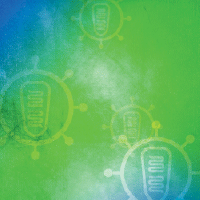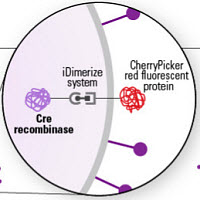Cre recombinase RLPs

Obtain a rapid burst of Cre expression in mammalian cells with footprint-free delivery of Cre mRNA in nonintegrating, virus-like particles. Cre RNA lentiviral particles (RLPs) contain no viral genome and are generated using a novel packaging technology that loads multiple biologically active mRNAs per particle. RLPs have been shown to mediate transient protein expression at high efficiency for in vitro and in vivo applications involving cell lines, primary cells, stem cells, tissues, and organisms.
Obtain a rapid burst of Cre expression in mammalian cells with footprint-free delivery of Cre mRNA in nonintegrating, virus-like particles. Cre RNA lentiviral particles (RLPs) contain no viral genome and are generated using a novel packaging technology that loads multiple biologically active mRNAs per particle. RLPs have been shown to mediate transient protein expression at high efficiency for in vitro and in vivo applications involving cell lines, primary cells, stem cells, tissues, and organisms.
Popular methods for Cre recombinase-based genome editing present tradeoffs. Transient transfection of a plasmid or mRNA limits the scope of Cre activity, minimizing the likelihood of unwanted effects associated with persistent Cre expression, but is associated with cellular toxicity, is unsuitable for in vivo applications, and is only feasible for cells that can be readily transfected. Transduction of the Cre gene sequence on a viral vector enables Cre expression in a broader range of cell types and can be applied to in vivo studies, but is associated with random genomic integration, may require activation and/or selection of target cells, and may result in undesirable persistence of Cre expression.
Cre recombinase RLPs enable researchers to overcome the above limitations and express Cre more rapidly and efficiently in mammalian cells by delivering nonviral Cre mRNA in lentivirus-derived packaging in the absence of a viral genome. In vitro studies involving RLP-mediated delivery of a luciferase reporter demonstrated that reporter expression was maximal at 4–24 hours post application and had declined rapidly at 30 hours. By contrast, expression of luciferase delivered via transfection was undetectable until 8 hours and peaked at 24 hours, while expression via lentiviral integration was undetectable until 24 hours. In an in vivo study involving a loxP mouse line (ROSA26-YFP), local injection of Cre RLPs into muscle yielded a zone of reporter gene expression that was comparable in size to a zone generated via injection of purified Cre lentivirus (Prel et al. 2015).
Overview
- Efficient delivery of active Cre mRNA via nonintegrating, virus-like particles (RLPs) enables rapid, transient Cre expression in mammalian cells
- Footprint-free RNA delivery avoids the use of a viral genome and risks associated with random genomic integration or persistent Cre expression and does not require activation or selection of target cells
- Suitable for a wide array of in vitro and in vivo applications, including use in immortalized cell lines, dividing and nondividing primary cells, stem cells, tissues, and various model organisms
- Available RLP formulations include Cre mRNA only (RLP-CRE-11, 0059VCT), or a combination of Cre and ZsGreen1 mRNAs (RLP-CRE-ZsGreen1-11, 0057VCT)
More Information
Applications
- Gene knockout or knockin studies involving loxP-based site-specific recombination
-
Transient Cre expression in a wide array of in vitro and in vivo systems, including cell lines, primary cells, stem cells, mouse models, etc.
References
Prel, A. et al. Highly efficient in vitro and in vivo delivery of functional RNAs using new versatile MS2-chimeric retrovirus-like particles. Mol Ther Methods Clin Dev. 2:15039 (2015).
Additional product information
Please see the product's Certificate of Analysis for information about storage conditions, product components, and technical specifications. Please see the Kit Components List to determine kit components. Certificates of Analysis and Kit Components Lists are located under the Documents tab.
Tools for delivering Cre recombinase
Rapid, efficient Cre recombinase delivery for genome modification
See how gesicle technology outperforms plasmid transfection for efficient delivery of Cre recombinase in most cell types.
Takara Bio USA, Inc.
United States/Canada: +1.800.662.2566 • Asia Pacific: +1.650.919.7300 • Europe: +33.(0)1.3904.6880 • Japan: +81.(0)77.565.6999
FOR RESEARCH USE ONLY. NOT FOR USE IN DIAGNOSTIC PROCEDURES. © 2025 Takara Bio Inc. All Rights Reserved. All trademarks are the property of Takara Bio Inc. or its affiliate(s) in the U.S. and/or other countries or their respective owners. Certain trademarks may not be registered in all jurisdictions. Additional product, intellectual property, and restricted use information is available at takarabio.com.





